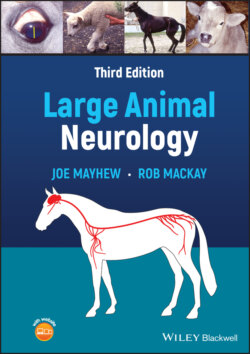Читать книгу Large Animal Neurology - Joe Mayhew - Страница 109
References
Оглавление1 1 Siegel JM. Clues to the functions of mammalian sleep. Nature 2005; 437(7063): 1264–1271.
2 2 Williams DC, Holliday TA, Aleman MR, et al. Sleep in the horse: an electroencephalographic study. Am Coll Vet Int Med Forum 2002; ACVIM.
3 3 Kryger MH, Roth DT and Dement WC. Principles and Practice of Sleep Medicine. 4th ed. Saunders, Elsevier, Philadelphia, PA. 2005; 1552.
4 4 Dallaire A and Ruckebusch Y. Sleep patterns in the pony with observations on partial perceptual deprivation. Physiol behav 1974; 12(5): 789–796.
5 5 Ruckebusch Y. The relevance of drowsiness in the circadian cycle of farm animals. Anim behav 1972; 20(4): 637–643.
6 6 Ruckebusch Y, Barbey P and Guillemot P. Stages of sleep in the horse (Equus caballus). Comptes rendus des seances de la Societe de biologie et de ses filiales. 1970; 164(3): 658–665.
7 7 Bertone JJ. Sleep deprivation not narcolepsy in horses. Proc 24th Annual Forum Am Coll Vet Int Med, Louisville KY. 2006; 24: 167–169.
8 8 Pizza F, Antelmi E, Vandi S, et al. The distinguishing motor features of cataplexy: a study from video‐recorded attacks. Sleep 2018; 41(5): zsy026–zsy.
9 9 Pillen S, Pizza F, Dhondt K, Scammell TE and Overeem S. Cataplexy and its mimics: clinical recognition and management. Curr Treat Options Neurol 2017; 19(6).
10 10 Lyle CH and Keen JA. Episodic collapse in the horse. Equine Vet Educ 2010; 22(11): 576–586.
11 11 Hughes KJ. Diagnostic challenge: lethargy and weakness in an Arabian foal with cardiac murmurs. Ventricular septal defect (VSD). Aust Vet J 2006; 84(6): 209–212.
12 12 Lyle CH, Turley G, Blissitt KJ, et al. Retrospective evaluation of episodic collapse in the horse in a referred population: 25 cases (1995–2009). J Vet Intern Med 2010; 24(6): 1498–1502.
13 13 Reading PJ. Update on narcolepsy. J Neurol 2019; 266(7): 1809–1815.
14 14 Young TJ and Silber MH. Hypersomnias of central origin. Chest 2006; 130(3): 913–920.
15 15 de Lecea L and Sutcliffe JG. The hypocretins and sleep. FEBS J 2005; 272(22): 5675–5688.
16 16 Mignot E and Nishino S. Emerging therapies in narcolepsy‐cataplexy. Sleep 2005; 28(6): 754–763.
17 17 Scammell TE. The neurobiology, diagnosis, and treatment of narcolepsy. Ann neurol 2003; 53(2): 154–166.
18 18 Dauvilliers Y and Buguet A. Hypersomnia. Dialogues clin neurosci 2005; 7(4): 347–356.
19 19 Dauvilliers Y, Challamel MJ and Touchon J. (Sleep disorders in children and adults). La Revue du praticien 2003; 53(17): 1937–1946.
20 20 Tafti M, Maret S and Dauvilliers Y. Genes for normal sleep and sleep disorders. Ann med 2005; 37(8): 580–589.
21 21 Black JE, Brooks SN and Nishino S. Narcolepsy and syndromes of primary excessive daytime somnolence. Semin Neurol 2004; 271–282.
22 22 Kotagal S and Pianosi P. Sleep disorders in children and adolescents. Br Med J 2006; 332(7545): 828–832.
23 23 ICSD‐3 AAoSM. International Classification of Sleep Disorders, 3rd ed. Buysse DJ, Ed. American Academy of Sleep Medicine, Darien, IL. 2014.
24 24 Peyron C and Charnay Y. (Hypocretins/orexins and narcolepsy: from molecules to disease). Revue neurologique 2003; 159(11 Suppl): 6S35–6S41.
25 25 Black JE, Brooks SN and Nishino S. Conditions of primary excessive daytime sleepiness. Neurol Clin 2005; 23(4): 1025–1044.
26 26 Baumann CR and Bassetti CL. Hypocretins (orexins) and sleep–wake disorders. Lancet Neurol 2005; 4(10): 673–682.
27 27 Crocker A, Espana RA, Papadopoulou M, et al. Concomitant loss of dynorphin, NARP, and orexin in narcolepsy. Neurology 2005; 65(8): 1184–1188.
28 28 Lodi R, Tonon C, Vignatelli L, et al. in vivo evidence of neuronal loss in the hypothalamus of narcoleptic patients. Neurology 2004; 63(8): 1513–1515.
29 29 Thannickal TC, Moore RY, Nienhuis R, et al. Reduced number of hypocretin neurons in human narcolepsy. Neuron 2000; 27(3): 469–474.
30 30 Thannickal TC, Siegel JM, Nienhuis R and Moore RY. Pattern of hypocretin (orexin) soma and axon loss, and gliosis, in human narcolepsy. Brain Pathol 2003; 13(3): 340–351.
31 31 Smith AJ, Jackson MW, Neufing P, McEvoy RD and Gordon TP. A functional autoantibody in narcolepsy. Lancet 2004; 364(9451): 2122–2124.
32 32 Liblau RS. Put to sleep by immune cells. Nature 2018; 562(7725): 46–48.
33 33 Boehmer LN, Wu MF, John J and Siegel JM. Treatment with immunosuppressive and anti‐inflammatory agents delays onset of canine genetic narcolepsy and reduces symptom severity. Exp Neurol 2004; 188(2): 292–299.
34 34 Schatzberg SJ, Cutter‐Schatzberg K, Nydam D, et al. The effect of hypocretin replacement therapy in a 3‐year‐old Weimaraner with narcolepsy. J Vet Intern Med 2004; 18(4): 586–588.
35 35 Toth B, Aleman M, Brosnan RJ, et al. Evaluation of squeeze‐induced somnolence in neonatal foals. Am J Vet Res 2012; 73(12): 1881–1889.
36 36 Schiffmann C, Hoby S, Wenker C, et al. When elephants fall asleep: a literature review on elephant rest with case studies on elephant falling bouts, and practical solutions for zoo elephants. Zoo Biol 2018; 37(3):133–145.
37 37 Klimova B, Maresova P, Novotny M and Kuca K. A global view on narcolepsy: a review study. Mini Rev Med Chem 2018; 18(5): 458–464.
38 38 Cheung J, Ruoff CM and Mignot E. Chapter 8 – Central Nervous System Hypersomnias. Ed. Miglis M G. Sleep and Neurologic Disease. Academic Press, San Diego. 2017; 141–166.
39 39 Evangelista E, Lopez R and Dauvilliers Y. Update on treatment for idiopathic hypersomnia. Expert Opin Investig Drugs 2018; 27(2): 187–192.
